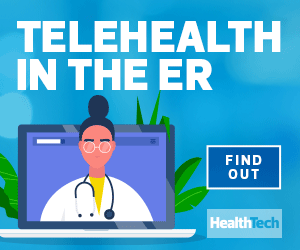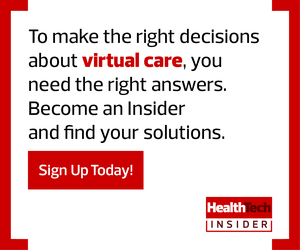For many COVID-19 patients, recovery from the virus can be a roller coaster. Some complications may arise or reappear after a discharge — and it could be difficult for a person to determine if returning to a high-risk public space is necessary.
Does a fever warrant a hospital visit? What about shortness of breath?
Remote patient monitoring (RPM) technologies that track and transmit a user’s vital signs can provide real-time insights for providers to determine next steps. Wearable tools such as thermometers and pulse oximeters gather data automatically; others (smartphone apps, for example) may require manual input.
These digitally connected, noninvasive technologies allow clinicians to monitor blood pressure, pulmonary function, temperature and other relevant physiology for changes in disease and symptom progression, the Healthcare Information and Management Systems Society notes.
And they’re especially critical right now: Recent studies connecting COVID-19 to long-term heart and lung damage, among other detrimental side effects, underscore the value of high vigilance during this period.
Benefits of Monitoring COVID-19 Patients at Home
By supporting proactive managed care — rather than responding to a preventable issue or waiting months for a follow-up visit — RPM is designed to curb readmissions. This not only benefits patients but also frees up busy staff to focus on new cases.
That’s the goal of a new COVID-19 monitoring platform developed at the University of San Diego and currently being tested at UC San Diego Health, where care teams had previously been calling discharged patients each day to check on them.
Now, some of these patients use a wearable device to continuously monitor vital signs such as heart rate and oxygen saturation levels, as well as their activity level and quality of sleep. They also complete a daily questionnaire via an app.
The information is sent to a secure dashboard that provides alerts and guidance for providers to prioritize caseloads and quickly pivot if the incoming data show signs of trouble.
“It also gives patients peace of mind knowing that they are being monitored and can quickly convey any changes in their status to our COVID team,” Dr. Michele Ritter, an infectious disease specialist at UC San Diego Health, said in a statement about the effort — which can be scaled to other health systems, its creators say.
Tracking Coronavirus Symptoms with Apps, Outreach and Wearables
Prior to the pandemic, RPM tools were becoming more common — including blood pressure cuffs, blood glucose monitors and patches that track medication adherence. A 2019 survey by Spyglass Consulting Group found that 88 percent of healthcare providers have invested in, or are evaluating, RPM technologies.
But as a public health emergency continues to expedite care delivery innovations, initiatives that may have been considered ancillary have become a key strategy.
“It’s really a question of, can we provide these devices to patients directly so that we can connect the physician and the patient virtually, and allow the [physicians] to keep providing excellent care during this time,” Connor Landgraf, chief executive of Eko, a digital medical device and intelligence company, recently told Stat.
Among the recent efforts:
- At Cleveland Clinic, a partnership with Epic allows recovering COVID-19 patients to enroll in a 14-day interactive care plan using Epic’s MyChart patient portal at home. They can enter symptoms, temperature and oxygen saturation once daily. Care providers will be automatically notified if symptoms worsen.
- Providence Saint Joseph Health patients who exhibit virus symptoms but are well enough to stay home are given a thermometer and pulse oximeter that connect with solutions from Twistle, Xealth and digital platforms monitored by Providence clinicians. It’s just one part of Providence’s digital COVID-19 strategy.
- OSF HealthCare launched an outreach program for those who are at high risk of contracting the virus or who are showing early symptoms. Participants receive a telehealth kit that includes a laptop with preloaded RPM apps. Patients monitor their signs and communicate twice daily with a nurse by phone or virtual visit.
- M Health Fairview relies on GetWell Loop, cloud-based patient management software, to track and communicate with home-based COVID-19 patients via smartphone or tablet. Ninety-eight percent of users say the platform helped them avoid a hospital visit or calling the doctor, an M Health Fairview leader said.
- Looking to the future, researchers at Northwestern University and Shirley Ryan AbilityLab in Chicago are testing a small wearable device that sits at the base of a patient’s throat to measure respiratory activity that is wirelessly transmitted to a HIPAA-protected cloud where algorithms produce graphical summaries.
As monitoring projects evolve, providers must continuously review user experience, adoption rates and resulting outcomes — as well as applicable legislation (the Food and Drug Administration issued guidance in March indicating it wouldn’t object to modifications in the use or function of RPM tools during the COVID-19 outbreak).
How to Set Up Remote Patient Monitoring in Healthcare
Organizations have many factors to consider when launching an RPM program — regardless of the intended use case or audience. Aetonix Systems and Vivify Health each have identified several key steps:
- Gather all stakeholders: Get leadership involved across departments to develop your RPM roadmap. Solicit deep, diverse feedback about which health concerns or logistical pain points to target; use those findings as a guide.
- Identify your audience: RPM isn’t a one-size-fits-all concept, and it’s best to start with a narrow focus. What patient population or illness could immediately benefit from RPM tools? Will you test it first for short- or long-term care efforts?
- Determine key goals: Providers must evaluate the intended results for specific populations using RPM — and how data-driven technologies can assist in reaching those objectives. Determine how will you measure and adjust over time.
- Assess infrastructure: Clinicians will receive constant streams of incoming data. Robust wireless connections as well as high-performing smartphones, tablets, computers and videoconferencing software are necessary.
- Choose the right devices: Based on your audience analysis and action plan, determine how you’ll facilitate RPM. Older patients may prefer preconfigured devices that are easy to use; younger people may want a BYOD approach.
- Train all users: Clear training and an open door for help at any time are invaluable to patient empowerment and participation. Providers should be trained to communicate this message and leverage the tools effectively.
For a deeper dive into launching an RPM program, the American Medical Association has developed a digital health implementation playbook. The guide, published in 2018, is a detailed resource for this complex and changing process.













